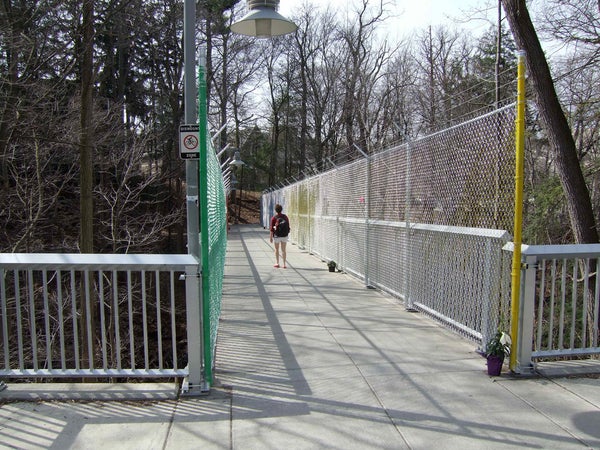This article was published in Scientific American’s former blog network and reflects the views of the author, not necessarily those of Scientific American
When I was a sophomore in college, our campus looked like a prison. My classmates and I walked to class between eight-foot tall chain-linked fences. Security guards patrolled bridges around the Ivy League school.
It was 2010 and, in the last academic year, six students had killed themselves at Cornell University. Two jumped off bridges into the Ithaca gorges on consecutive days in March. Classmates anxiously checked in on one another. Parents panicked. The administration scrambled to maintain a sense of calm on campus.
That’s when the fences went up.
On supporting science journalism
If you're enjoying this article, consider supporting our award-winning journalism by subscribing. By purchasing a subscription you are helping to ensure the future of impactful stories about the discoveries and ideas shaping our world today.
Fencing in students to stop suicides might seem extreme. But Cornell isn’t the only school to take drastic suicide prevention measures in recent years. In 2003, New York University installed glass barriers in the atrium of its 12-story Bobst Library after a spate of student suicides there. Even so, a distressed student climbed over one of these walls and jumped to his death in 2009; the university has since replaced these glass panels with metal screens to prevent further incidents.
College is often billed as the “best four years of your life.” But, for many students, this couldn’t be further from the truth. Mental health experts estimate that more than 1,000 college students kill themselves every year, and research has found that suicide is one of the leading causes of death among college students. Over the last several years, suicide clusters at schools including the University of Pennsylvania, Tulane University, and Colorado State University have drawn national attention.
In the past, schools have relied on a set of traditional approaches to prevent suicides. For example, universities might hire more mental health counselors or set up 24-hour crisis hotlines. Student health centers have distributed posters and brochures raising awareness about warning signs for suicide. Faculty and student groups have campaigned against the stigmatization of mental illness.
These are important steps towards promoting mental health on campus. College students need better access to mental health services, and changing the ways in which we view mental illness might help many students get the care they need. Yet, despite these nationwide efforts, hundreds of college students still kill themselves each year. Thousands more carry out suicide attempts that nearly end their lives.
To combat this national crisis, schools are turning towards new ideas for suicide prevention.
At Miami University in Ohio, administrators partnered with a free smartphone app called Just In Case to help guide students through mental health crises. The app screens for mental health issues and can connect students with emergency responders. Other schools including the University of California, Riverside, Pace University, and Rutgers University have formed similar partnerships over the last few years.
In 2015, Drexel University became the first US college to unveil a mental health screening kiosk on its campus, according to the Chronicle of Higher Education. The touch-screen tablet screens students and faculty for conditions ranging from depression to substance abuse to bipolar disorder. Drexel has encouraged students to get a “check-up from the neck up” and the kiosks are now popping up on other campuses like Montgomery County Community College.
Other colleges have come up with unique—and sometimes controversial—ways of addressing mental health issues. MIT recently installed artificial light boxes meant to curb depression and seasonal affective disorder among students. At Yale, Dr. Marney White, an associate professor of epidemiology and psychiatry, has called for mandatory annual mental health screenings of college students. Faculty at the City University of New York and William Paterson University have proposed monitoring students’ social media for suicidal content, and reports by Politico suggest this may already be happening at some schools.
Legislation across the country has placed further pressures on colleges to ramp up suicide prevention efforts. From New Jersey to Ohio to Texas, state policymakers have passed laws requiring mental health outreach and access to treatment on college campuses.
As more legislatures demand action from colleges and universities, we may see more kiosks, apps, and other novel approaches to suicide prevention on campuses. But will this changing landscape of college mental health make a difference? The true test of these solutions is whether they can enhance student wellbeing—and ultimately save lives.
The fences stayed up for over three years at Cornell. In 2013, I returned to campus as an alumnus, after the fences were taken down and replaced with hidden nets. Standing on the College Avenue bridge, I looked out onto an unobstructed view of the gorges. The chain-linked fences were no longer there as a reminder of the suicides from years ago.
A few feet beneath me, nets hung just in case.
